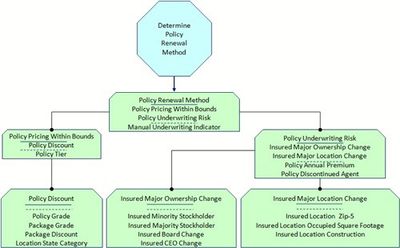Difference between revisions of "Decision Model"
m |
|||
| Line 1: | Line 1: | ||
| − | The '''Decision Model''' is an intellectual template for perceiving, organizing, and managing the | + | The '''Decision Model''' is an intellectual template for perceiving, organizing, and managing the business logic behind a business decision. The Decision Model provides a framework for organizing business rules into well-formed decision-based structures that are predictable, stable, maintainable, and normalized. More than this, the Decision Model directly correlates business logic to the business drivers behind it, allowing it to be used as a lever for meeting changing business objectives and marketplace demands.The Decision Model is not simply a list of business rules or business statements. Rather, it is a model representing a structural design of the logic embodied by those statements. As a model of business logic, the Decision Model is a unique representation of business logic, unlike other representations. For example, it is, by deliberate intent, not a model of how that business logic relates to processes, use cases, information, or software models. It is not a notation added to data models, fact models, process models, or any other kind of model. Instead, it is an independent representation of business logic based on the premise that business logic has its own existence, independent of how it is executed, where in the business it is executed, and whether or not its execution is implemented in automated systems. The Decision Model can be anchored to any and all other kinds of models, but maintained independently of them.<ref>Definition - What is the Decision Model? [http://www.ittoday.info/ITPerformanceImprovement/Articles/2011-03VonHalleGoldberg.html Barbara von Halle and Larry Goldberg]</ref> |
| Line 7: | Line 7: | ||
===See Also=== | ===See Also=== | ||
| − | [[ | + | *[[Vroom-Yetton model]] |
| − | [[ | + | *[[EPIC ADVISERS Model]] |
| − | |||
| − | |||
| − | |||
===References=== | ===References=== | ||
<references/> | <references/> | ||
Latest revision as of 12:09, 7 January 2023
The Decision Model is an intellectual template for perceiving, organizing, and managing the business logic behind a business decision. The Decision Model provides a framework for organizing business rules into well-formed decision-based structures that are predictable, stable, maintainable, and normalized. More than this, the Decision Model directly correlates business logic to the business drivers behind it, allowing it to be used as a lever for meeting changing business objectives and marketplace demands.The Decision Model is not simply a list of business rules or business statements. Rather, it is a model representing a structural design of the logic embodied by those statements. As a model of business logic, the Decision Model is a unique representation of business logic, unlike other representations. For example, it is, by deliberate intent, not a model of how that business logic relates to processes, use cases, information, or software models. It is not a notation added to data models, fact models, process models, or any other kind of model. Instead, it is an independent representation of business logic based on the premise that business logic has its own existence, independent of how it is executed, where in the business it is executed, and whether or not its execution is implemented in automated systems. The Decision Model can be anchored to any and all other kinds of models, but maintained independently of them.[1]
See Also
References
- ↑ Definition - What is the Decision Model? Barbara von Halle and Larry Goldberg

